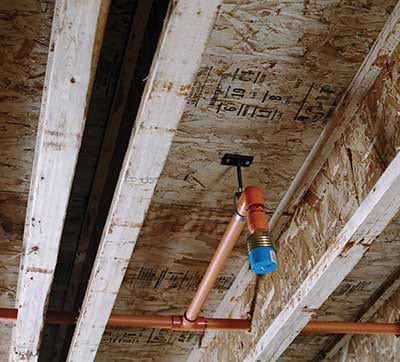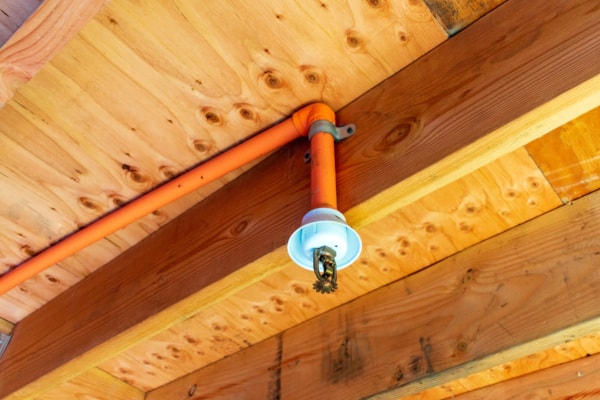Though fire sprinklers are not required in residential garages and some other spaces by NFPA 13D, some local jurisdictions do mandate extra coverage
Two fires suffered by fire protection industry veterans illustrate the value of residential fire sprinkler systems in very different ways. One fire was effectively controlled by a single sprinkler, causing minimal damage. The other one happened in a home without sprinklers, resulting in a total loss of the property and a very narrow escape for its occupants. But one thing these two incidents share is that both fires started in places not typically covered by fire sprinklers.
As we reviewed in our recent Thank You for Sprinkler Safety post, a blaze that started in fire protection engineer Bob Shifiliti’s home garage was controlled and limited to that area by a fire sprinkler. In contrast, a fire that began on Viking Group President and CEO James Golinveaux’s back deck spread into the unsprinklered house, completely engulfing the property.
Golinveaux shared his experience in a video supporting this year’s Fire Protection Week. He recounts the emergency moment by moment along with his mistakes, chief of which was not sufficiently practicing an evacuation plan. And while his last four homes had been sprinklered, he had not yet retrofitted his newest one:
In the span of just sixty seconds, we faced multiple life decisions which could have ended in a very different story. […]
[M]ost of all we ask that you do what we should have done — have a family safety plan and PRACTICE IT, install heat detectors in sensitive areas, do not leave batteries longterm on chargers, and install fire sprinklers if you can.
These two incidents with very different outcomes highlight some issues surrounding home fire sprinklers. First, though both the International Code Council (ICC) and NFPA model codes require residential sprinkler systems in new homes, only two states, DC, and some local jurisdictions have adopted these requirements as legally enforceable codes. And a separate consideration is where sprinklers aren’t required in residences under these codes and the model installation standards they reference, including garages, porches, decks, and other spaces.
Here’s a look at the relevant aspects of codes and standards, along with the fire protection rationale for coverage omissions:
ICC and the International Residential Code
The ICC’s International Residential Code (IRC) is a model code applicable to single-family homes and two-unit townhouses. Since 2009, the IRC has included a requirement to include fire sprinklers in all of these new residences.
The residential fire sprinkler requirements are found in section R313, and installation guidance is outlined in section P2904.
From the 2021 edition of the IRC
R313.2 One- And Two-Family Dwellings Automatic Sprinkler Systems
An automatic sprinkler system shall be installed in one- and two-family dwellings.
R313.2.1 Design and Installation
Automatic sprinkler systems shall be designed and installed in accordance with Section P2904 or NFPA 13D.
Navigating to section P2904, the user finds that the section mandates sprinklers in “all areas of a dwelling unit,” with some exceptions—one of them being garages. And if a system is installed using NFPA 13D: Standard for the Installation of Sprinkler Systems in One- and Two-Family Dwellings and Manufactured Homes, that standard has the same exception for sprinkler protection of garages and some other areas:
From the 2022 edition of NFPA 13D
8.3.4* Sprinklers shall not be required in garages, open attached porches and balconies, carports, and similar structures.

NFPA and the Life Safety Code
Fire protection requirements for one- and two-family dwellings are addressed in NFPA 5000: Building Construction and Safety Code and NFPA 101: Life Safety Code. Sections 24.3.5 of NFPA 101 and 22.3.5 of NFPA 5000 contain similar language requiring sprinkler protection following the rules in NFPA 13D.
From the 2021 edition of NFPA 101
24.3.5* Extinguishment Requirements.
24.3.5.1* All new one- and two-family dwellings shall be protected throughout by an approved automatic sprinkler system in accordance with 24.3.5.2.
24.3.5.2 Where an automatic sprinkler system is installed, either for total or partial building coverage, the system shall be in accordance with Section 9.7.
24.3.5.3 Automatic sprinkler systems in accordance with NFPA 13, NFPA 13R, or NFPA 13D shall be permitted.
Sprinkler installation standards and the NFPA 13D rules
NFPA 13D is the accepted standard for one- and two-family dwellings and applies to most residential fire sprinkler systems. This document outlines design criteria, system components, permitted sprinkler types, and where sprinklers should be located in the home.
Its minimum requirements for installation and maintenance are simpler and less expensive than other standards (NFPA 13 and NFPA 13R), a conscious design choice to spur greater adoption of this lifesaving technology. Again, some of these considerations include various exemptions for sprinkler coverage that may or may not apply in certain jurisdictions, which we’ll cover below.

Codes and the adoption process
While NFPA and ICC require sprinklers in new homes, they are merely model codes—and states, municipalities, and other jurisdictions often adopt but amend these requirements. The current legal adoption status of residential fire sprinkler mandates in all new homes falls into three categories:
- States that have not adopted the model code’s residential fire sprinkler requirements but permit local jurisdictions to adopt residential fire sprinkler requirements.
- States that have not adopted the residential fire sprinkler requirements but do not allow local jurisdictions to adopt residential fire sprinkler requirements.
- States that have adopted the residential fire sprinkler requirements.
To date, only California, Maryland, and the District of Colombia have made the residential sprinkler requirement in the IRC and NFPA model codes law, along with some local jurisdictions, such as Scottsdale, Arizona.
In addition, some of the states and local governments that adopted sprinkler requirements did so with additional amendments. For example, California not only requires one- and two-family dwellings to be fully sprinklered, it also goes further than the NFPA 13D installation rules by mandating coverage of attached garages.
Again, residential fire sprinkler systems are primarily intended for life safety, not property protection. As such, there are other areas besides garages where sprinkler protection is not required. These spaces share the characteristic that they are not “lived in”— the presence of people in a fire incident is unlikely—or the hazard is otherwise low. The areas exempted by NFPA 13D include smaller bathrooms or closets, pantries, carports, attached open structures, attics, and other concealed non-living spaces.
To sprinkler or not to sprinkler—with or without installation exceptions
As we wrote in our previous blog, the reasoning for sprinkler coverage exceptions is straightforward:
- It may be impractical to install sprinklers in some of these spaces.
- The standard is designed to make home fire sprinklers as easy and inexpensive to install as possible while still achieving life safety goals.
- The main goal of residential sprinkler systems is life safety—specifically, making sure occupants have time to escape as sprinklers control a fire. Because most of those areas are not ‘lived-in’ spaces, they are a lesser protection priority.
This reasoning by life safety committees has likely caused far greater adoption of affordable but effective systems, saving more lives and property. Nevertheless, the fire in Bob Shifiliti’s home garage does show that sprinklers can increase safety in some of these areas, which is why some jurisdictions insist on sprinklering them.
But what about the fire at Viking Group President and CEO James Golinveaux’s home?
As he notes in his video, “the fire started outside where the sprinklers probably would not have been on the back deck, but that’s no excuse. I should have retrofitted this house.”
In any case, stunning footage from Golinveaux’s home security camera dramatically illustrates the essential purpose of residential fire sprinklers. At the 4:43 mark below, everyone exits the house, but Golinveaux’s brother realizes that he doesn’t have his wallet and phone. He briefly turns back and looks inside but makes a critical decision not to re-enter the house. Five seconds later, flames, smoke, and glass blow through the front door when the room becomes completely involved in fire:
While it is impossible to know the exact effect of residential sprinklers in this fire that started outside, these systems and residential heads are designed to avoid such close calls. Residential sprinklers are fast response—they have a thinner bulb more sensitive to temperature changes that enables them to activate faster. They also use deflectors that create a broad, high spray pattern to prioritize wall-wetting. The effect and purpose of these features are to delay flashover—the total involvement of space in fire—and give people more time to escape.
Thus, while we can’t know how well sprinklers would have controlled the fire in Golinveaux’s emergency, they likely would have bought everyone more time to get out by wetting the interior’s fuel sources—regardless of where the fire started.
Home fires account for about 26% of fire incidents and 75% of civilian fire deaths—and sprinklers reduce their fatality rate by 87% and control fires 96% of the time. In addition, residential systems are relatively inexpensive, as the National Fire Sprinkler Association (NFSA) explains:
The average expense to install sprinkler systems in new homes is about $1.35 per square foot. With the average construction cost of a single-family home at $114 per square foot in 2019, that’s paying a little more than 1% of a home’s value for 24/7 fire protection. When the expense is spread over a 30-year mortgage, it’s less than the price of a cup of coffee per week.
So, legal sprinkler mandate in your area or not—and some model installation exceptions or none—these systems are a compelling and cost-effective choice. Fire sprinklers save lives!
QRFS is on a mission to simplify fire protection through access to affordable products and information that make it easier for everyone to stay safe and compliant. Contact us at (888) 361-6662 or support@qrfs.com.
This blog was originally posted at QRFS.com/blog. If this article helped you learn something important, check us out at Facebook.com/QuickResponseFireSupply or Twitter @QuickResponseFS.


